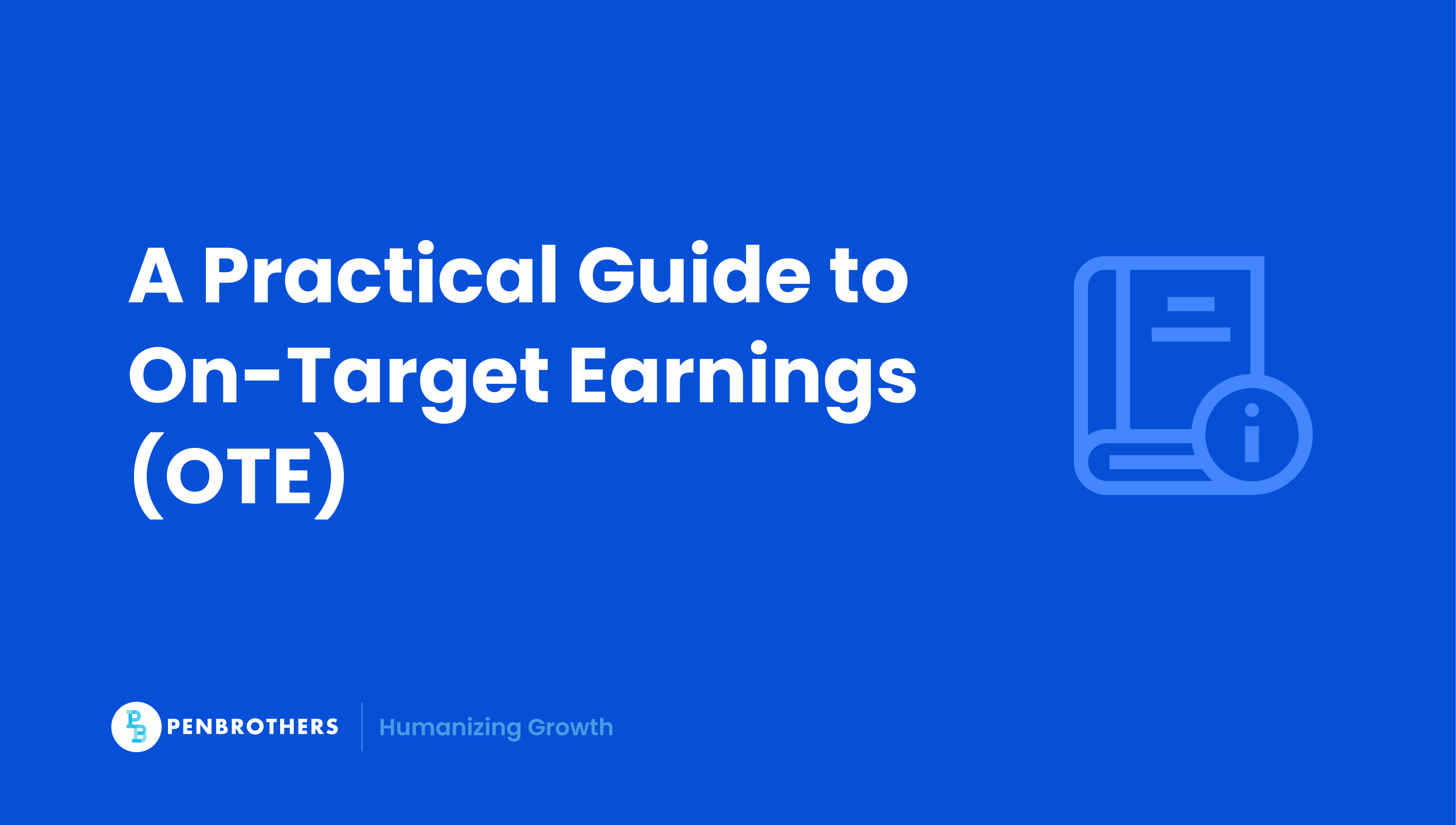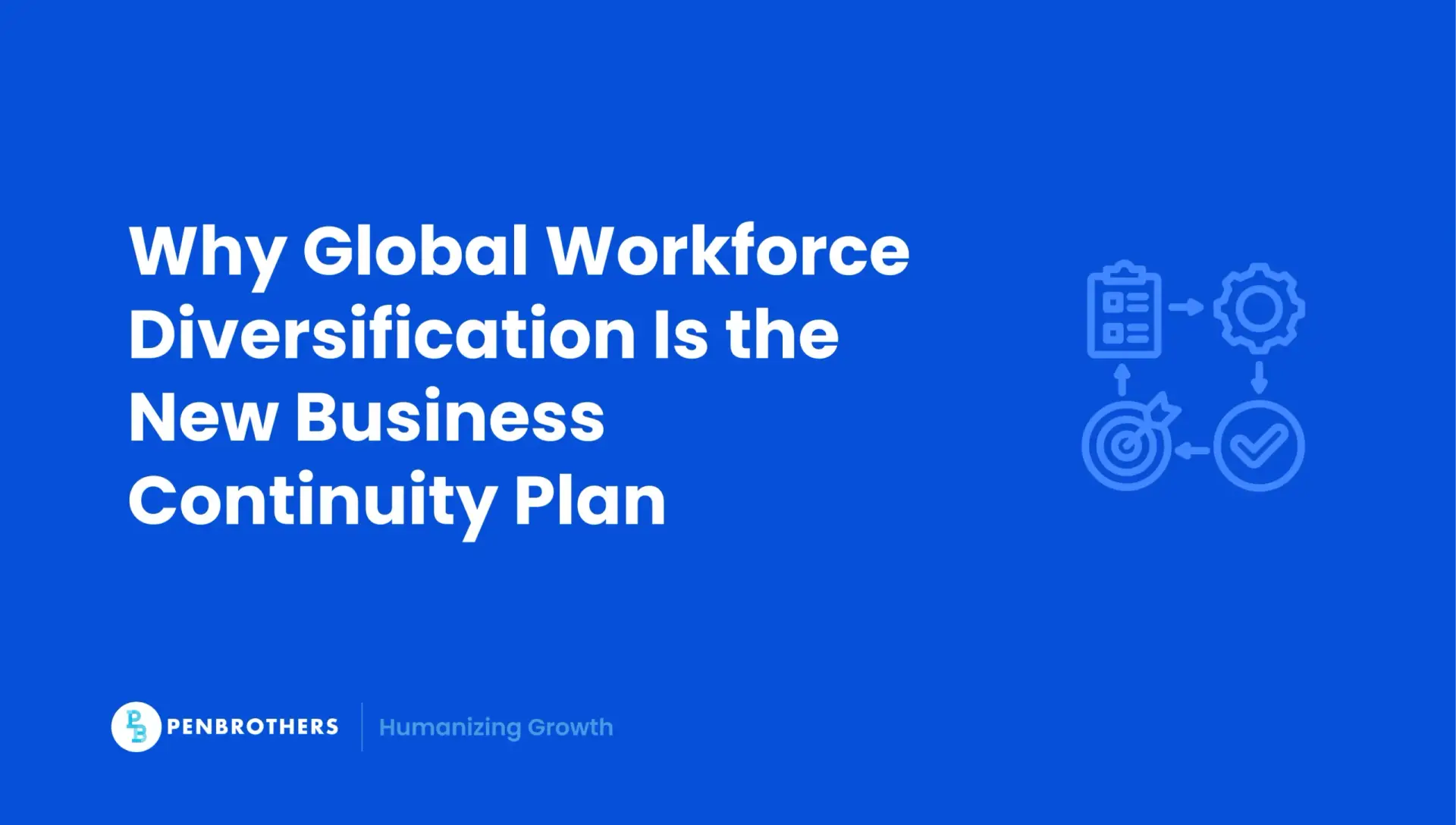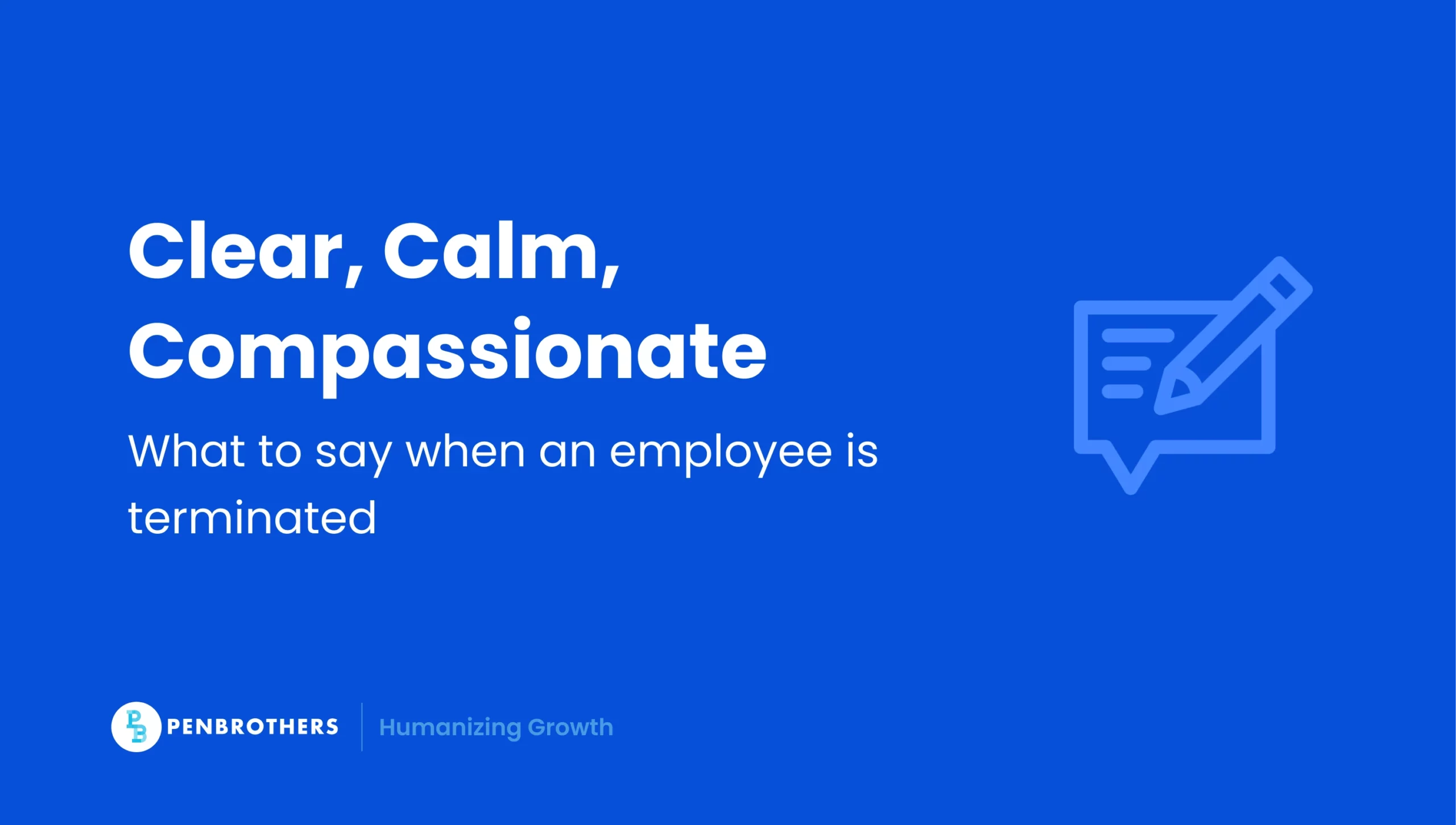What's Inside?
OTE Meaning: A Simple Guide for Employers and Job Seekers

Key Takeaways
- OTE is the sum of base salary and variable pay, not a guaranteed figure.
- Clear, transparent OTE structures build trust with candidates.
- Effective OTE relies on measurable, business-aligned goals.
- OTE applies to sales, marketing, customer success, and leadership roles.
- Achievable quotas are critical to retention and performance.
- Job seekers should question quota realism, pay mix, and attainment rates.
You’re scanning job boards and spot an attractive sales role: “$120,000 OTE.” It sounds generous—but what does it actually mean? Is it guaranteed? How much is base salary versus commission? For employers, unclear OTE figures can discourage strong candidates. For job seekers, misunderstanding OTE can lead to disappointment, mistrust, and even turnover.
In today’s competitive talent market, clarity on OTE (On-Target Earnings) is more than a compensation detail, it’s a trust signal.
What Does OTE Mean?
OTE stands for On-Target Earnings—the total pay an employee can expect if they meet 100% of their performance goals.
It combines:
- Base salary (the fixed pay)
- Variable pay (commissions, bonuses, or incentives tied to performance)
But here’s the catch: OTE is projected, not guaranteed. A job offering $100K OTE might include only a $60K base salary. The other $40K comes from hitting performance targets.
Before comparing OTE across jobs, it helps to understand how salaries differ by market. For instance, check the Philippines’ average salary to see how compensation aligns globally.
How to Calculate OTE (With a Simple Formula)
At its core, OTE is simply the sum of fixed and variable pay if an employee achieves 100% of their performance goals.
Formula:
Base Salary + Incentives (at 100% Quota) = OTE
Example Calculation
- Base salary: $60,000 (guaranteed annual pay)
- Commission at full quota: $40,000 (earned only if sales targets are met)
- Total OTE = $100,000
In this scenario, the employee is guaranteed $60K but can earn up to $100K if they meet their targets.
Why This Matters
- Projected, not guaranteed: OTE shows the potential top-line pay, but actual earnings depend on quota attainment. If average performance in a team is only 70% of quota, the realistic annual earnings might be closer to $88K rather than $100K.
- Gross vs. net: OTE is always expressed as gross earnings. After mandatory deductions like net pay adjustments and payroll taxes, take-home pay will be lower.
- Transparency builds trust: Employers should be clear about how commissions are calculated—whether it’s straight-line, tiered, or includes accelerators once reps exceed quota.
Pro Tip: Job seekers evaluating OTE should always ask: “What percentage of your team usually hits 100% of quota?” That single number can reveal whether the OTE is a realistic target or just an inflated figure to attract applicants.
OTE vs. Base Salary vs. Bonuses: Key Differences
Understanding how OTE differs from other forms of pay is essential for setting fair expectations on both sides of the hiring table.
1. Base Salary
- What it is: The fixed, guaranteed portion of pay an employee receives regardless of performance.
- Why it matters: Provides financial stability and predictable income for employees. For employers, it’s the “anchor” cost that must be budgeted for every hire.
2. Bonuses
- What they are: One-off or discretionary payments, often tied to company performance (e.g., profit-sharing, end-of-year rewards, or spot bonuses).
- Why it matters: While they can boost morale, bonuses are less predictable than commissions or structured incentives. Employees cannot rely on them as consistent income.
3. OTE (On-Target Earnings)
- What it is: A projection of total earnings if performance goals are met, combining base salary with commissions or performance-based incentives.
- Why it matters: Unlike a bonus, OTE is tied directly to measurable targets (like quota attainment), making it a more structured form of variable pay.
Why This Distinction Matters
- For employers: Being clear about what portion of pay is fixed versus variable reduces the risk of misaligned expectations and early attrition. A job advertised as “$100K OTE” but delivering only $65K in realistic earnings damages employer branding.
- For job seekers: Understanding the difference helps candidates evaluate whether the variable portion is achievable or overly optimistic. An offer with a high OTE but low quota attainment rates may not be as attractive as it seems.
Types of OTE Structures (Capped vs. Uncapped)
Not all OTEs are created equal.
- Capped OTE: There’s a maximum commission payout, even if you exceed quota. Predictable for budgeting, but can frustrate top performers.
- Uncapped OTE: The sky’s the limit. Great for motivating high achievers, but less predictable for employers.
Many companies also define pay mix (the ratio of base vs. variable pay). In SaaS sales, a 50/50 split is common, while marketing roles may lean 70/30 or 80/20.
But the effectiveness of OTE isn’t just about pay mix—it’s about goal design. A McKinsey survey found employees were more motivated when goals combined individual and team targets, linked clearly to company objectives, and were specific and measurable. OTE works best when tied to transparent, business-aligned metrics—not arbitrary numbers.
Real-World OTE Examples by Role
OTE isn’t just a sales concept—it applies across multiple functions where performance impacts pay. Below are common role-based examples to make the idea more concrete:
1. Account Executive (AE)
- Base salary: $60,000
- Commission (at 100% quota): $40,000
- Total OTE: $100,000
- Context: AEs typically carry quotas tied to revenue targets. Many companies use a 50/50 pay mix (half base, half commission) to balance financial security with strong performance incentives.
2. Sales Development Representative (SDR)
- Base salary: $42,000
- Commission (at 100% quota): $28,000
- Total OTE: $70,000
- Context: SDRs usually have a 70/30 or 65/35 pay mix, with most of their income guaranteed and a smaller portion tied to meetings booked or pipeline created. This mix reflects their role as early-career contributors.
3. Director of Marketing
- Base salary: $90,000
- Performance bonus: $30,000
- Total OTE: $120,000
- Context: Marketing leaders often earn bonuses tied to pipeline contribution, lead volume, or campaign ROIrather than individual sales quotas. Their OTE structure ensures alignment between marketing output and revenue growth.
4. Customer Success Manager (CSM)
- Base salary: $70,000
- Variable incentives: $20,000 (tied to client renewals and satisfaction scores)
- Total OTE: $90,000
- Context: CSMs may not “sell,” but they drive renewals and expansions. Incentives linked to retention rates and upsells make their OTE meaningful and aligned with company growth.
5. Sales Leader (Regional Manager)
- Base salary: $110,000
- Variable incentives: $40,000 (based on team quota attainment)
- Total OTE: $150,000
- Context: Leadership OTEs are typically weighted toward team performance, encouraging managers to coach and support rather than compete with their teams.
These examples highlight how OTE applies beyond sales—it’s also relevant in marketing, leadership, and customer success.
What Employers Should Consider When Offering OTE
Designing fair and competitive OTE packages requires more than copying benchmarks. Employers should:
1. Ensure Quotas Are Achievable
- Why it matters: If employees consistently achieve only 50–60% of quota, it signals a structural problem, either goals are inflated or resources are insufficient. This leads to burnout and rapid attrition.
- Best practice: Analyze historical attainment rates and set quotas that a majority of the team can reasonably achieve. Stretch goals should exist, but the average performer should be able to reach 80–100% of quota with consistent effort.
2. Stay Competitive With Market Standards
- Why it matters: Compensation is one of the first things candidates compare. If your OTE lags behind similar roles in your industry or region, you risk losing talent before the first interview.
- ]Best practice: Benchmark OTE ranges against peers in your sector and geography. Adjust pay mixes (e.g., 50/50 vs. 70/30) depending on the role and seniority. For offshore or distributed teams, calibrate compensation to both local salary norms and global competitiveness.
3. Provide Absolute Transparency
- Why it matters: Ambiguity around commissions or bonuses breeds mistrust. Candidates want clarity on whether OTE is realistic or just a recruiting hook.
- Best practice: Put the full commission plan in writing, covering:
- Is pay capped or uncapped?
- Do accelerators kick in after exceeding quota?
- How often do quotas reset—quarterly or annually?
- What happens during ramp-up for new hires?
4. Align OTE With Business Strategy
- Why it matters: A misaligned OTE structure can drive the wrong behavior. For example, rewarding only new sales may discourage account managers from focusing on retention.
- Best practice: Balance incentives across acquisition, retention, and upsell metrics to ensure employees are motivated to contribute to the company’s long-term goals, not just short-term wins.
5. Factor in Payroll and Compliance Realities
- Why it matters: For global or offshore teams, the perceived value of OTE can change once taxes, benefits, and deductions are factored in. Misalignment here can make an attractive package seem disappointing after the first paycheck.
- Best practice: Be upfront about how payroll works in each location. For example, many companies share how payroll works in the Philippines so offshore candidates understand their net pay and statutory benefits clearly.
What Job Seekers Should Ask About OTE
If you’re a candidate evaluating a role with OTE, don’t just accept the headline figure. Ask:
- “What’s the average attainment rate for this role?”
- If most employees earn only 60–70% of OTE, the advertised number is inflated. A fair employer will share past attainment data openly.
- “Is the commission capped or uncapped?”
- Capped structures limit high performers, while uncapped models reward those who exceed quota. Knowing this upfront tells you how much growth potential the role really offers.
- “How is quota determined and adjusted over time?”
- Quotas based on realistic market conditions and historical data are achievable. Be cautious if quotas are reset aggressively each quarter without regard to past performance.
- “How often do team members hit 100% of OTE?”
- This question exposes whether the compensation plan is designed for success or for underpayment. Ideally, the majority of the team should be consistently close to target.
- “What’s the pay mix between base salary and variable pay?”
- A 50/50 mix is common in sales, but other roles may lean toward 70/30 or 80/20. The higher the variable portion, the more dependent your income will be on performance.
These questions separate realistic offers from inflated ones. To validate numbers, job seekers can even use an offshoring salary calculator to model real-world earnings.
A 2023 Gartner survey noted that compensation transparency is a top-three factor in retaining sales talent, yet fewer than 50% of companies provide clear quota attainment data during hiring.
Final Thoughts
OTE is a powerful motivator when structured fairly. But left vague, it’s a recipe for mistrust and attrition.
For employers, offering a competitive and transparent OTE can set you apart in the war for talent. For job seekers, understanding the details helps you evaluate whether an offer is realistic—or just shiny marketing.
If you’re an employer designing compensation plans, ask yourself: Is my OTE structure motivating the right behavior or pushing people out the door? If you want help building transparent, competitive salary structures for offshore teams, Penbrothers is here to help.
*This article was crafted with the support of AI technology and refined by a human editor.





